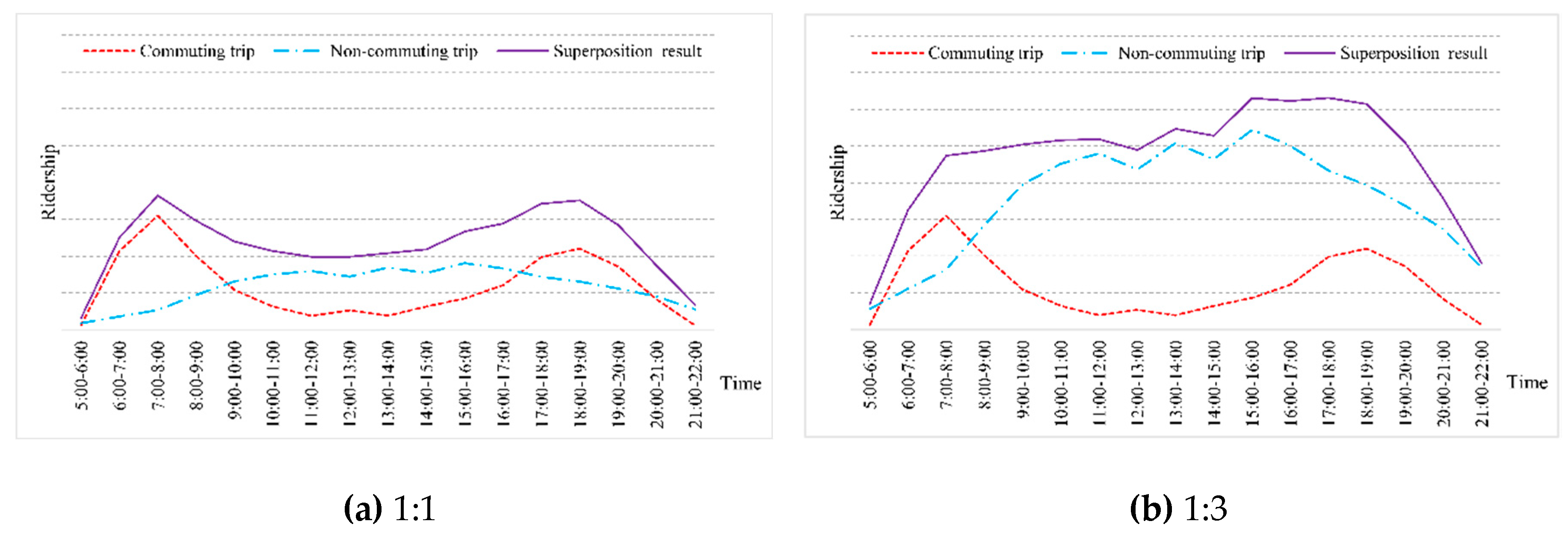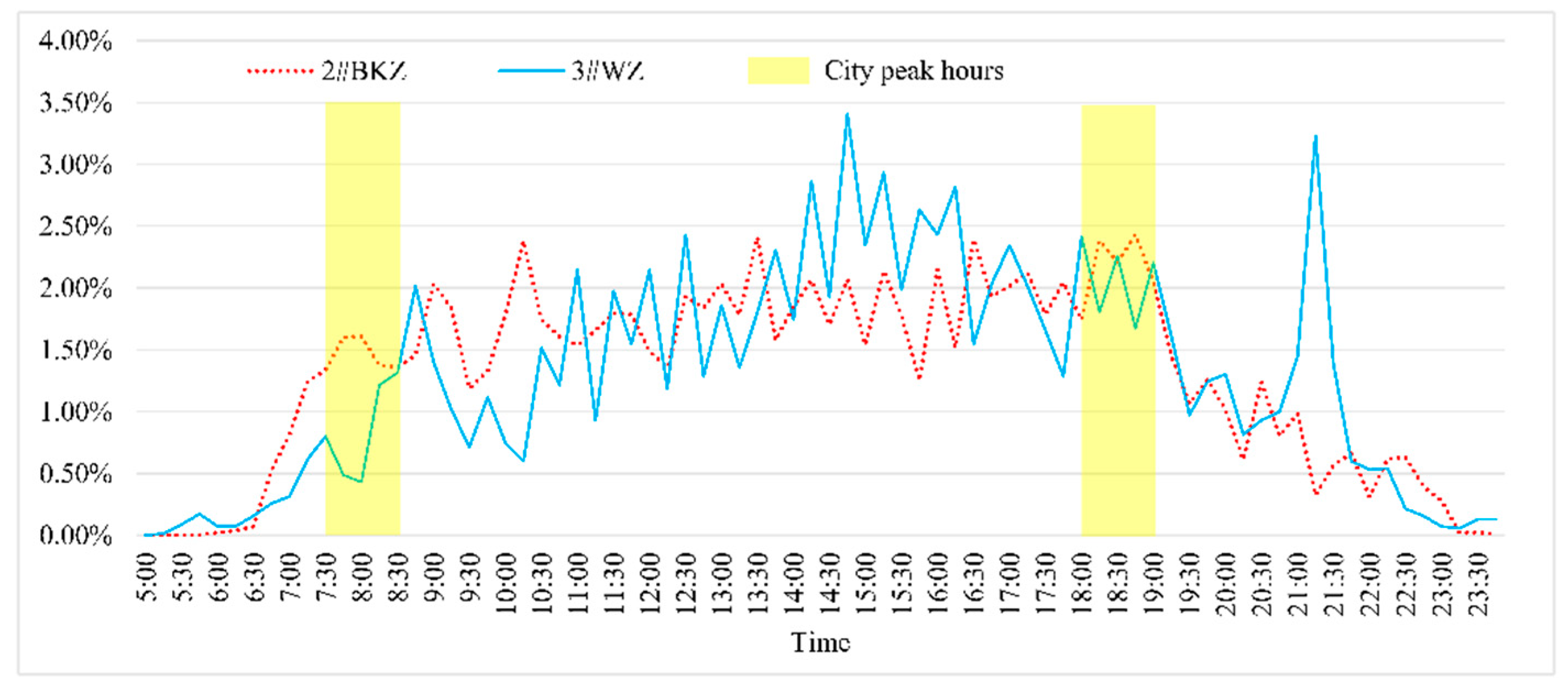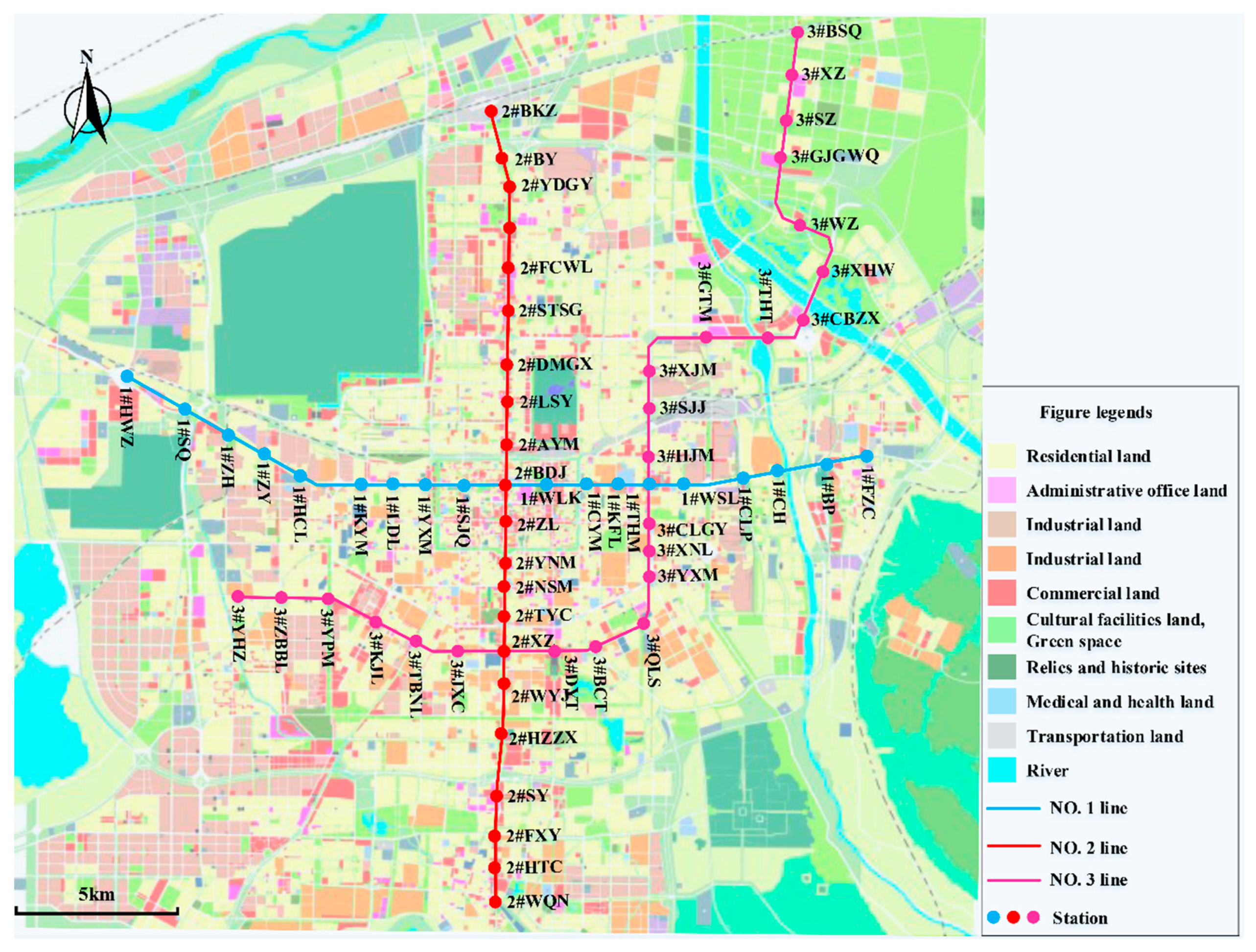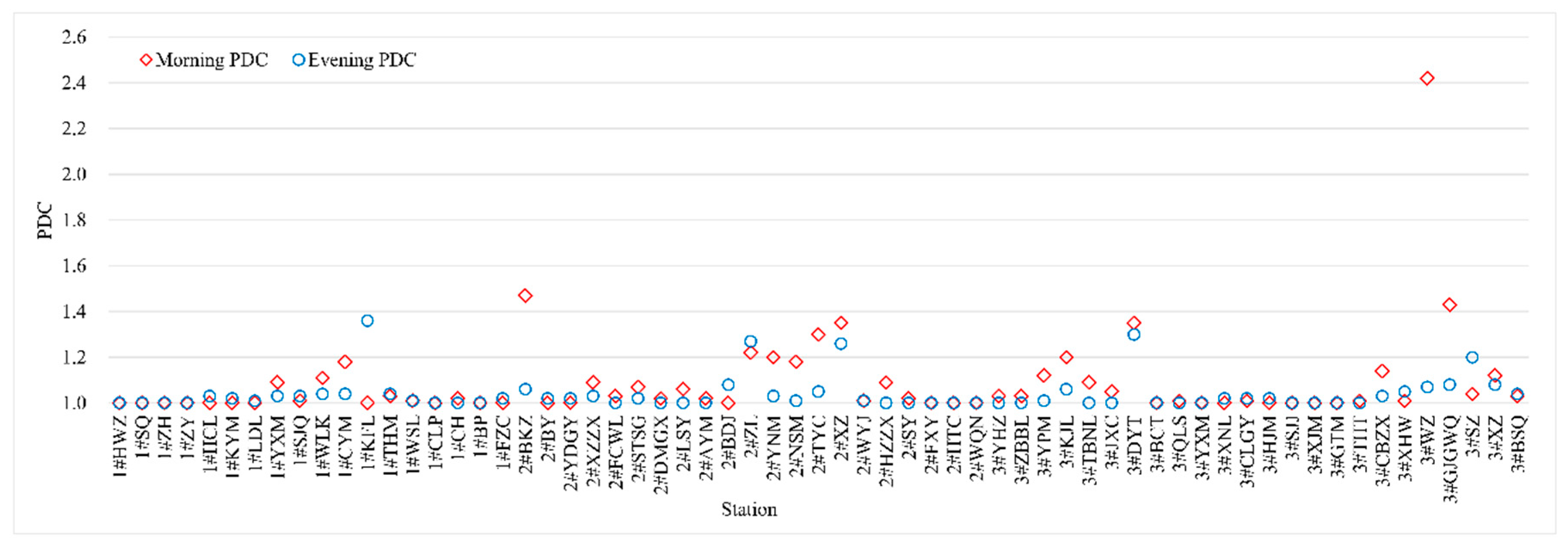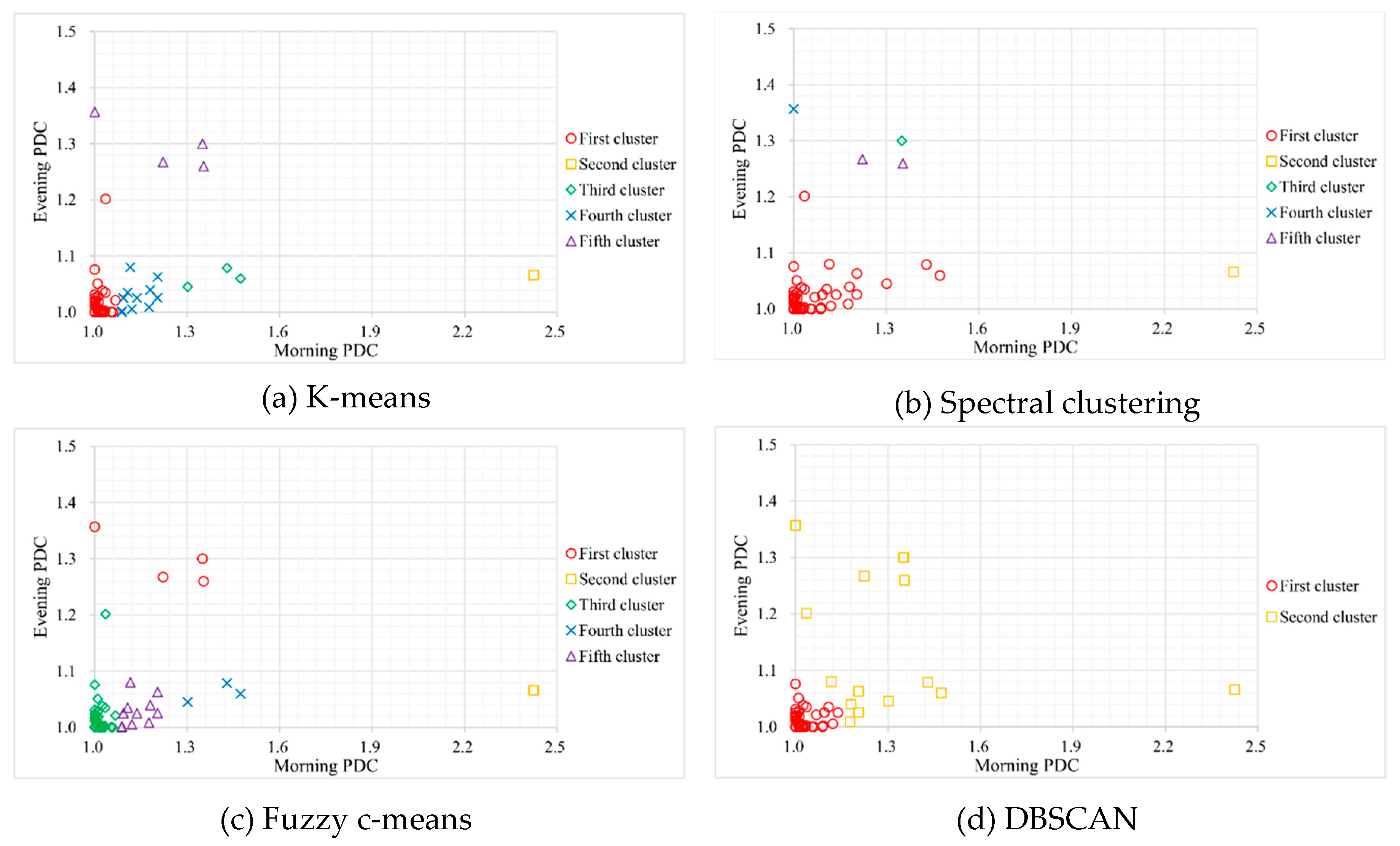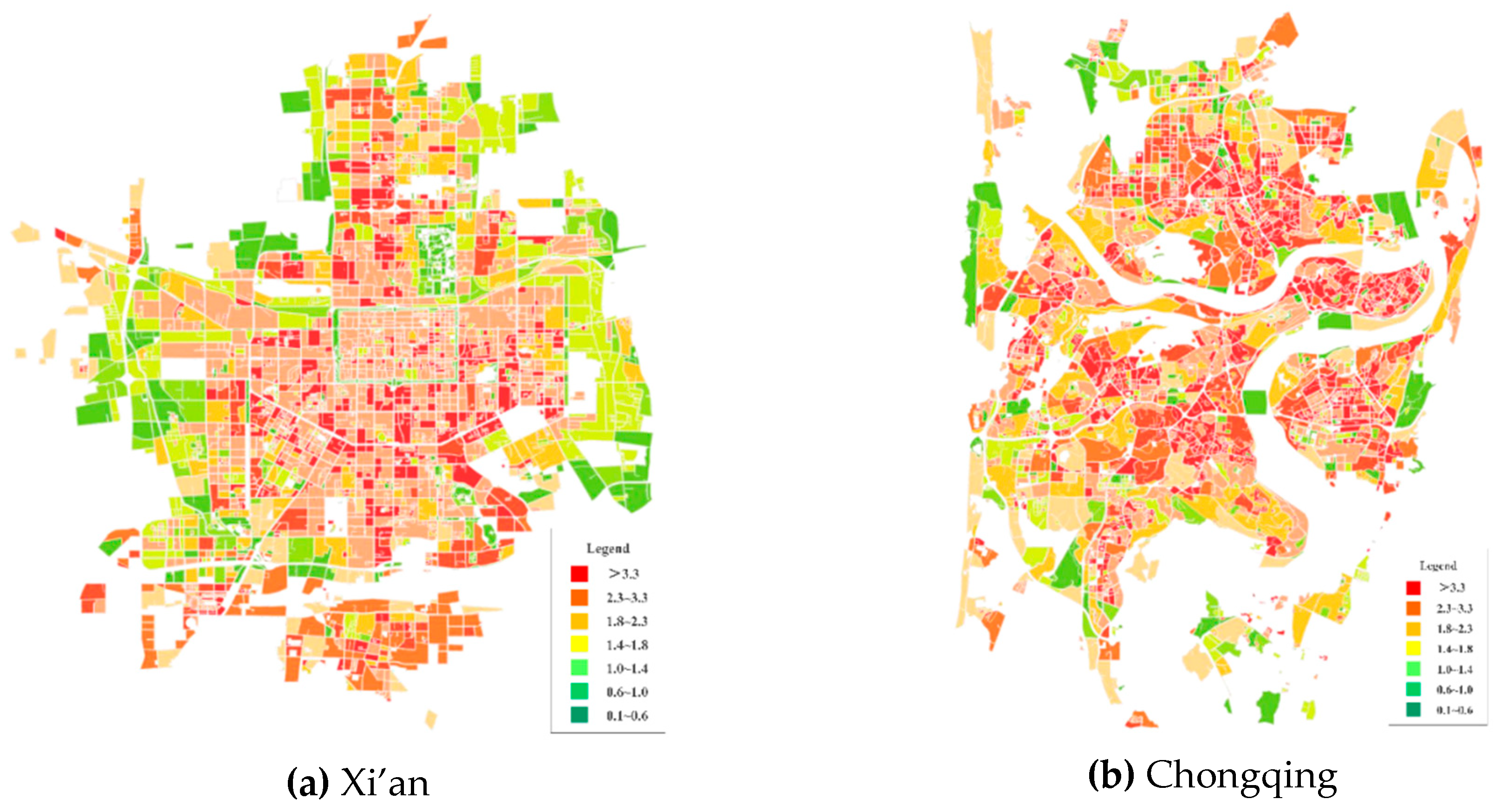1. Introduction
Urban rail transit has existed for over 150 years, with global large-scale construction of urban rail transit emerging in the 1970s. At present, over 150 cities in over 50 countries have subways, with a total length reaching beyond 10,000 km.
Due to the long service life of urban rail, it is necessary to build rail transit according to passenger flow forecast results to adapt the rail for future travel traffic. As urban rail transit develops, research into passenger flow forecasting also continues to expand. Researchers initially studied the four-stage method, and have gradually developed more advanced passenger flow forecasting methods [
1,
2] which include total control, and the distribution of passenger flow on the rail transit network [
3,
4]. Some scholars have investigated the difference between actual operation results and the passenger flow forecast by analyzing the problems in passenger flow forecasting [
5,
6,
7], shortcomings of the traditional four-stage method, and introducing improvements [
8,
9,
10,
11,
12]. Rail transit lines gradually extend into the suburbs as cities develop and expand. Due to the difference between the mode of travel in the suburbs and in urban areas, research on the forecast method of passenger flow in suburban rail transit has also emerged [
13,
14,
15,
16]. To satisfy the demand for refined operations, a number of scholars have studied short-term passenger flow forecasting [
17,
18,
19], and abnormal passenger flow forecasting [
20,
21]. Station scale also directly affects passenger perception of the rail transit service level. When studying the passenger flow of a station, its location, the nature of the land, and connection with other modes of transportation have emerged as important influencing factors [
22,
23,
24,
25]. The application of passenger flow forecasting results for the calculation of rail transit station scale has also been investigated [
26,
27].
With the operation of urban rail transit, it has become apparent in many areas that station peak hours are not completely consistent with those of the city. This phenomenon is referred to as the deviation of peak hours for urban rail transit stations in this paper. Peak hour deviation has emerged in the Chinese cities of Xi’an and Chongqing, where statistics have been collected. The statistical results are presented in
Table 1. The data for Xi’an spans from September 2017 to May 2018, and is provided by Xi’an Metro Co., Ltd. The data for Chongqing is in 4 May 2016 (Wednesday), and is provided by Chongqing Rail Transit Co., Ltd. The two cities all possess unique features. Xi’an is a plain city, while Chongqing is a mountainous city. As seen in
Table 1, the two cities all exhibit deviations between the peak hours of urban rail transit stations and those of the cities.
At present, station design is based on passenger flow forecast for the station at the city peak hour. As a result, some stations with large deviations experience problems such as inadequate station size and chaotic passenger flow in the station during their real peak hours. To address these issues, various scholars have investigated the temporal distribution of urban rail transit stations. Zhong [
28] used one-week of smart-card data in London, Singapore and Beijing to analyze the time change regulation of human mobility entering subway stations. Ma [
29] introduced temporal variation into traditional geographically weighted regression (GWR) and leveraged geographically and temporally weighted regression (GTWR) to explore the spatiotemporal influence of the built environment on transit ridership. Shi [
30] used a geographically and temporally weighted regression (GTWR) model to examine the spatial and temporal variation in the relationship between hourly ridership and factors related to the built environment and topological structure. Zhu [
31] employed a Bayesian negative binomial regression model to identify the significant impact factors associated with entry/exit ridership at different periods of the day, formulating geographically weighted models to analyze the spatial dependency of these impacts over different periods.
In 2008, Shen [
32] determined that ridership in the station peak hour was different to the station ridership in peak hours, differentiating the two individual concepts. Kudarov [
33] applied a least squares method for forecasting the capacity of the urban rail transit during rush hours. However, these predictions were only focused on stations already in operation. Gu’s [
34] study found that location and trip purpose are related to the passenger flow in a station’s peak hours. However, this method cannot be used for an unopened line due to the as yet unknown trip purpose for those who will use it. Cheng’s [
35] study forecasted the peak period station-to-station origin–destination matrix, but this technique cannot locate the appearance of peak hours.
In the latest edition of Passenger Flow Forecasting Specification in China, Code for Prediction of Urban Rail Transit Ridership (
GB/T51150-2016), it is stated that for the stations in which passenger flow peak does not appear in the morning and evening peak hours of the city, the station’s own peak hour and passenger flow volume should be predicted [
36]. Due to the lack of theoretical basis, rail transit passenger flow forecast reports for each city can only provide results from a qualitative angle. Therefore, the enlargement coefficient of the passenger flow volume in station peak hours should be determined. This means that in future rail transit station design, the predicted passenger flow volume in city peak hours can be multiplied by the expanded multiple, providing a more accurate foundation for station design.
The aim of this paper is to determine influence factors of the enlargement coefficient, which can change the boarding and alighting volume of a station from the city peak hours to the station’s own peak hours. This research also attempts to determine the relationship and variation tendency between the enlargement coefficient and influence factors.
4. Discussion
Analyzing the relationship between PDC and the proportion of commuting trip land in Xi’an shows that if the proportion of commuting trip land is below 0.5, most PDCs are over 1.10. If the proportion of commuter travel land is no less than 0.5, most PDCs are under 1.10. The distribution of plot ratio in Xi’an and Chongqing [
53] is shown in
Figure 9. The plot ratio in Xi’an decreases from the city center to the periphery areas because it is a plain city. The high plot ratio in Chongqing is distributed in many areas because it is a mountainous city and the land is separated by mountains and rivers. Thus, the morphological structure of the two cities are not the same. If the relationship between PDCs and the proportion of commuting trip land in Chongqing is similar to Xi’an, the results will provide some universal applicability. The relationship between rail transit station PDC and the proportion of commuting trip land in Chongqing is analyzed in the following section.
The data in Chongqing were taken 4 May 2016 (Wednesday), and included 83 stations from Line 1, Line 3, and Line 6. Before conducting statistical evaluation, the stations with undeveloped land were removed from the sample, and 52 stations remained. The PDC and proportion of commuting trip land of Chongqing rail transit stations are provided in
Table 7.
The statistical relationship between rail transit station PDCs and the proportion of commuting trip land in Chongqing is shown in
Table 8. As seen in the table, 78.26% of stations where the proportion of commuting trip land is more than 0.50 have morning PDCs under 1.10, and 89.13% have evening PDCs under 1.10. The stations where the proportion of commuting trip land is less than 0.50 have polarized morning PDCs, in which 33.33% of station PDCs are under 1.10, and 66.67% of station PDCs are over 1.10. All stations with a proportion of commuting trip land that is less than 0.50 have evening PDCs over 1.20. This result is in accordance with Xi’an in that most of the urban rail transit stations’ peak hours were completely consistent with that of the cities when their proportions of commuting trip land were more than 0.50, and most of the urban rail transit stations’ peak hours were not completely consistent with that of the cities when their proportions of commuting trip land were less than 0.50. However, in Chongqing, the deviation of peak hours is high in the evening, and this result is not coincident with the result in Xi’an.
5. Conclusions
This paper investigated the inconsistencies of passenger flow volume between station peak hours and city peak hours for 63 rail transit stations in Xi’an. To verify the results, 53 rail transit stations in Chongqing were also analyzed. The key findings are as follows:
Current ridership data in Xi’an and Chongqing illustrate the phenomenon that urban rail transit station peak hours are not completely consistent with that of the cities. Thus, using station ridership data in peak hour to design stations may produce some errors.
The temporal distribution of the station is the superposition of different temporal distributions of the purpose determined by land-use attributes. Temporal distribution is determined by the proportion of different land-use attributes, and also dictates if the station peak hour is consistent with the city peak hour or not.
Peak deviation coefficient (PDC) was introduced to describe the inconsistencies of passenger flow volume between station peak hours and city peak hours. It is the ratio between the predicted volume in the station’s own peak hour, and the city’s peak hour. When designing a station, only the predicted boarding and alighting volume in city peak hours is required. The boarding and alighting volume of the station can then be established by multiplying by PDC.
The relationship between PDC and land-use attributes was also determined. For the stations in Xi’an without undeveloped land, 92.00% of stations with a proportion of commuter travel land over 0.50 have morning PDCs under 1.10, and 98.00% of the stations have evening PDCs under 1.10. All stations with a proportion of commuter travel land less than 0.50 have morning PDCs over 1.10. The stations where the proportion of commuter travel land is less than 0.50 have polarized evening PDCs. In this case, 62.50% of the stations have PDCs under 1.10, and 37.5% of the stations have PDCs over 1.20.
The results from Chongqing were in accordance with Xi’an in that most metro station peak hours are completely consistent with that of the city when their proportions of commuter travel land are more than 0.50, and most metro station peak hours are not completely consistent with that of the city when their proportions of commuter travel land are less than 0.50.
By determining the law between PDC and land-use attributes, this paper provides a mechanism to select a suitable amplification coefficient when designing rail transit stations based on passenger flow forecasting.
The shortcomings of this research are acknowledged as follows. Firstly, the PDCs are not the same every day, and the rangeability for each station is also different, indicating that other influencing factors which change daily also influence the PDCs. Secondly, this paper only considers the boarding and alighting volume, but does not take transferring passengers in the interchange stations into consideration. The occurrence of peak hour transferring volume is the result of the accumulation from upstream stations, and is influenced by the peak hours of these stations boarding and alighting volume. Further research focusing on these issues is required.

